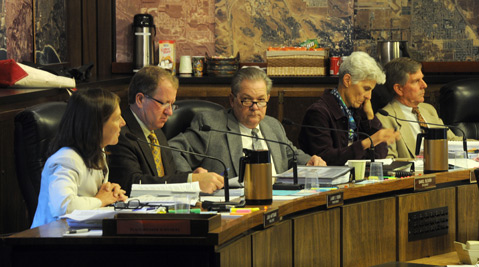Global Warming Soaks Up Attention
Planning Commission Approves Energy and Climate Action Plan

If there was a week to be hip to climate change, this was it. With the echo of the 400,000 activists who marched through New York City streets on Sunday hitting the South Coast, three planning commissioners on Tuesday gave the green light to the county’s plan — years in the making — to combat global warming, forwarding the final decision to the Board of Supervisors. Gathered ahead of this week’s United Nations Climate Summit — where President Barack Obama said global warming was an “issue that will define the contours of this century more dramatically than any other” — 100 supporters of Measure P, the November ballot measure aiming to ban all new fracking, acidizing, and cyclic steam injection operations, rallied in Plaza Vera Cruz Park. And on Wednesday, Representative Lois Capps joined Supervisor Salud Carbajal at UCSB to discuss how Santa Barbara County can gird itself against the ravages of a warming world.
“The evidence, scientifically, is in,” said Planning Commissioner Joan Hartmann at Tuesday’s meeting, pointing to a graphic showing the small sliver of scientific studies out of 10,000 that questioned that climate change is man-made. Hartmann, who participated in the New York City demonstration, gave an impassioned speech in support of the county’s plan, calling it “imperative” that smaller jurisdictions, removed from a “paralyzed” Congress, take charge of the issue. “The very processes that support life on Earth are being undermined,” she said. “I’m very pleased that Santa Barbara County is acting.”
The plan, which looks to lower greenhouse-gas emissions in the county’s unincorporated areas by 15 percent, or to 2007 levels, by 2020, would impose required and requested steps on homeowners and business owners. Pending the supervisors’ approval, voluntary measures would be implemented first, with the mandatory ones visualized in annual county budget talks. Much of the plan centers around offering incentives to make houses and buildings more energy efficient. County planner David Lackie said ordinances and permit processes will likely have to be established to get the ball rolling and will require an investment on the county’s part in increased staff time.
If all goes as intended, every year, the efforts could cut 186,900 metric tons of carbon dioxide, the emissions equivalent of more than 39,000 cars, from the county’s unincorporated regions, which produced 1,192,970 metric tons in 2007 (the plan doesn’t apply to UCSB, Vandenberg Air Force Base, the Chumash reservation, or offshore oil and gas projects). The climate action plan faced some minor backlash from real estate agents and farmers — construction interests supported it — who asked that the stipulations be made voluntary. Commissioners Larry Ferini and Daniel Blough, who voted against it, said they felt the same. But Commissioner Michael Cooney said that the county could have made all of the programs mandatory. “It’s a spit in the ocean. We have an incredible distance to go to make any difference,” Cooney said. “But it’s a start.”
Also starting something this week out of concern for climate change were the Rockefellers heirs to the Standard Oil fortune. The family added their names to a growing list of people and organizations vowing to divest from oil and gas interests. The $823.3 million investment pool of Santa Barbara County — half of which comes from K-12 schools and community colleges — isn’t tied to any corporations, including those related to fossil fuels, said Treasurer Harry Hagen. Less than 5 percent of the $2.5 billion portfolio for the county’s Retirement Board is wrapped up in the energy sector, said Greg Levin, interim CEO of Santa Barbara County Employees’ Retirement System (SBCERS). Levin said the board has considered divesting that portion from oil interests but doesn’t currently have a plan in place to do so.
Because of state law, explained city Finance Director Bob Samario, the City of Santa Barbara invests none of its $172 million portfolio in stock — including energy company stock. It does hold a few corporate securities, including Toyota and General Electric, but none from fossil fuel companies. As for the city’s retirement fund, it is invested by the state’s public employee retirement system, CalPERS. The fund’s most recent financial statement, June 2013, shows ExxonMobil topping the stock-holding list ($1.2 billion) with Chevron at number five ($752 million) of its overall $261 billion holdings.
While UCSB doesn’t make its own divestment decisions, the University of California system puts $10 billion of its $91 billion portfolio in energy-related assets, but future divestment is a possibility; on the flip side, the UC Regents recently voted to funnel $1 billion over the next five years into climate-change-related assets. Pensions for Santa Barbara City College employees fall under the statewide CalPers and CalSTRS programs, the latter of which — in the wake of the Sandy Hook shootings — started divesting last year from companies that manufacture guns deemed illegal in California; CalSTRS has yet to take a stance on oil holdings. Westmont College doesn’t adhere to the United Nations’ Principles for Responsible Investment, which advocates against investing in the energy sector, and invests in a managed fund rather than individual companies



